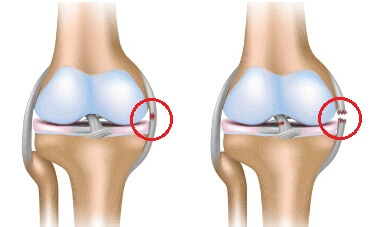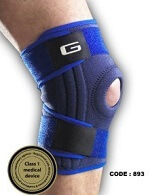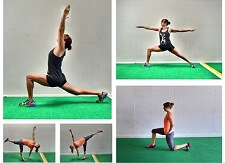- Home
- Common Knee Injuries
- MCL Tear
MCL Tear
Written By: Chloe Wilson, BSc(Hons) Physiotherapy
Reviewed by: KPE Medical Review Board
An MCL tear is a common knee injury that develops when the medial collateral ligament of the knee gets overstretched and damaged.
The MCL is one of four ligaments that helps to stabilise the knee and is found on the inner side of the joint.
A medial collateral ligament injury is most commonly caused by sudden twisting or a force through the knee, which damages some or all the fibres of the ligament and occasionally some of the other surrounding structures as well such as the knee cartilage.
There are three grades of MCL tear depending on what proportion of the ligament is injured. Medial collateral ligament injury symptoms include inner knee pain, swelling and instability.
Here we will look at what causes MCL tears, the different grades of ligament injuries and their symptoms, treatment options, and what you can do to prevent long term problems after an MCL injury.
Common Causes of MCL Tears
Knee ligament injuries are extremely common, especially a tear to the Medial Collateral Ligament.
The two most common causes of an MCL tear are:
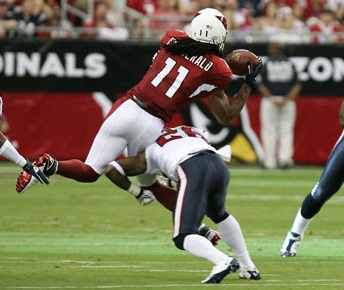
- Contact: An MCL injury usually occurs when there is a force through the outer side of a
bent knee, e.g. a tackle hitting the outer side of the knee. This pushes the
bones apart on the inside of the knee which overstretches the ligament tearing the MCL
- Twisting: Sudden twisting of the knee, such as changing direction quickly, particularly if you are wearing studs that fix the foot to the floor, can over-stretch the ligament, resulting in an MCL tear
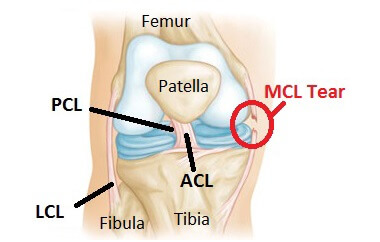
The MCL is one of the four main ligaments that help to stabilise the knee so it can function properly.
It is a strong, flat band of connective tissue found on the inner side of the knee joining the femur (thigh bone) to the tibia (shin bone).
The function of the MCL is to provide stability, holding the tibia and femur bones together and stopping them moving apart on the inner side of the knee.
This helps keep the knee nice and stable. But if sufficient force is placed through the ligament that it is overstretched, then it will tear resulting in pain, inflammation and instability.
MCL Tear Classification
MCL tears can be classified into three different grades, each varying in severity.
Here you will find information on how they are classified and the symptoms, treatment options and recovery time for each:
Grade 1 MCL Injury
What Is It: With a grade 1 MCL tear only a few of the fibres are damaged, less than 10%
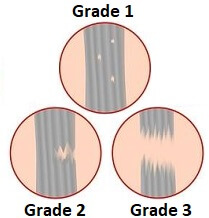
Symptoms: Grade 1 tears are usually tender on the inner side of the
knee especially when any pressure is put through the region and
bruising and mild swelling may develop over the first couple of days. There is unlikely to be any instability.
Treatment: PRICE principles (protect, rest, ice, compression and elevation) are usually sufficient for treating a great 1 medial collateral ligament injury. Visit the PRICE treatment section to find out how to make the best recovery.
Recovery: A grade 1 MCL injury usually heals itself within a couple of weeks
Grade 2 MCL Injury
What Is It: With a grade 2 MCL tear more fibres are damaged (up to 90%) but the ligament remains intact
Symptoms: There may be medial knee pain with a moderate
amount of swelling and bruising (which appear in the first 48 hours),
and the knee may feel slightly unstable
Treatment: PRICE first. A grade 2 medial collateral ligament injury may also benefit from using tubigrip compression bandage or a hinged knee brace in the short term if the knee is giving way to help provide stability and prevent further injury.
Ultrasound treatment and deep tissue friction massage can also help reduce pain and speed up healing from an MCL injury. This is usually carried out by a physical therapist or sports therapist. Strengthening and movement exercises help to regain full range and function in the knee
Recovery: Grade 2 MCL injuries normally settle down within 4-6 weeks
Grade 3 MCL Injury
What Is It: A grade 3 MCL tear is when the ligament ruptures i.e.tears completely
Symptoms: There will be significant swelling with a grade 3 medial collateral ligament injury and it is often difficult to bend the knee, although it is sometimes less painful than a grade 2 sprain. The knee will likely feel unstable and may give way
Treatment: A knee brace can be really helpful if the knee is feeling unstable. People usually find an advanced or elite knee brace most helpful as they help prevent any sideways movement at the knee.
Your doctor may advise you to get a knee brace that prevents bending or straightening of the knee initially, depending on the severity of the injury. Braces are a great way to reduce pain and instability, improve function and prevent further MCL injury.
Knee exercises should be done to help to increase movement, strength and circulation, all of which will lead to a quicker, fuller recovery. If you are wearing a brace, it should be removed several times a day to carryout exercises to ensure the knee does not get stiff.
Crutches may be needed in the short term to keep weight off the knee when walking around after a medial collateral ligament injury. The crutches can stop being used once you can walk without a limp.
Recovery: Symptoms often take 6-8 weeks to settle and
it can take 3-4 months to fully recover from a grade 3 MCL tear.
Recovery will be quicker if you keep up with your exercises. A
combination of strengthening and movement exercises should be done daily
- see the
knee exercises
section for suitable exercises.
Remember, always consult your doctor or a rehab therapist after any injury to ensure the most effective course of action for you.
How to Avoid Long Term Problems
A medial collateral ligament injury can have a long lasting impact on the stability of the knee therefore affecting balance and knee function e.g. running on uneven ground and quickly changing direction, so it is important to rehab properly, particularly with grade 2 and grade 3 MCL tears.
You may want to see a therapist for a rehab programme or try these exercises that you can do at home. But don’t worry, with proper rehabilitation, most people make a full recovery from all grades of MCL injury.
As some of the fibres of the MCL connect to the medial meniscus, in more serious injuries this is often damage too - see the Meniscus Tear section for more information.
MCL Tear Summary
AN MCL tear is a common knee injury where the medial collateral ligament gets over-stretched and tears.
An MCL tear is a common cause of inner knee pain, inflammation and instability.
There are three grades of MCL tear depending on how much damage there is.
Symptoms of an MCL tear usually develop quickly following an injury. If you didn't twist your knee or don't have pain on the inner side of your knee, it is unlikely you have an MCL tear.
Treatment for medial collateral ligament tears usually involves a combination of PRICE, exercises, knee braces, physical therapy or, in severe cases, surgery
You might also be interested in the following articles:
- Knee Pain & Popping
- Swollen Knee Treatment
- Front Knee Pain
- Side Knee Pain
- Pain Behind The Knee
- Burning Knee Pain
- Knee Range Of Motion
- Knee Pain On Stairs
- Common Knee Injuries
Page Last Updated: 25/05/23
Next Review Due: 25/05/25
